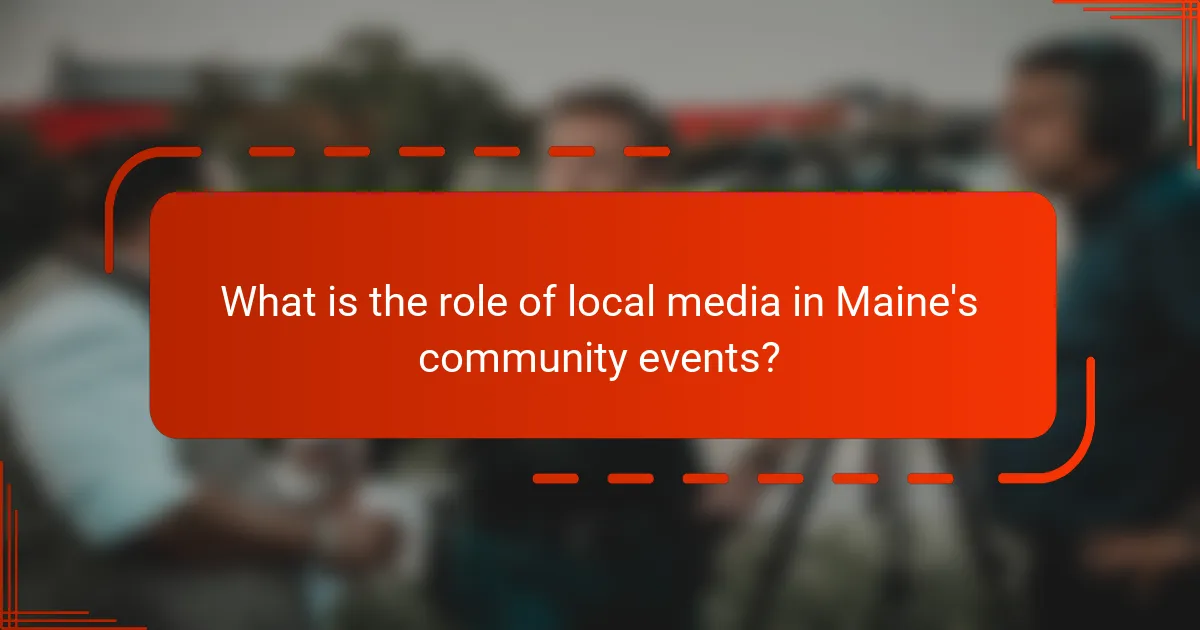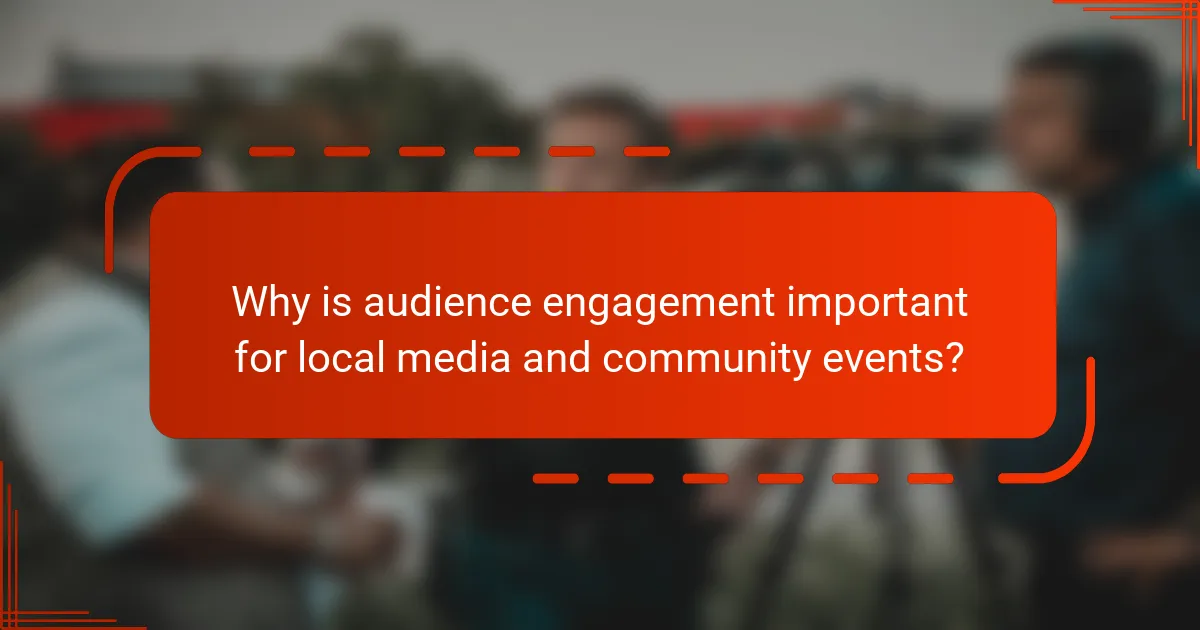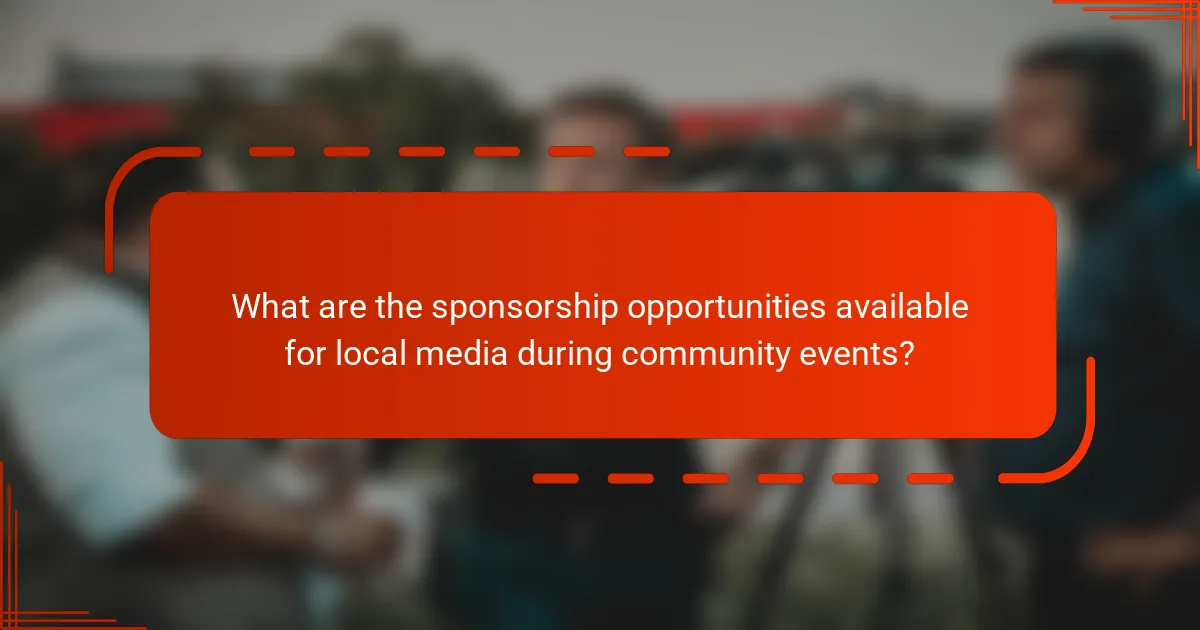Local media in Maine plays a vital role in promoting community events by providing coverage that informs residents about upcoming activities. This coverage not only boosts attendance and participation but also highlights the importance of these events for community engagement. Through interviews with event organizers and attendees, local media fosters connections among community members while offering sponsorship opportunities for businesses. Engaged audiences are more likely to participate in events, leading to increased attendance and enhanced media coverage. Additionally, local media can tailor their content to reflect community values, strengthening trust and credibility with their audience. Overall, the collaboration between local media and community events contributes to the vibrancy and sustainability of community life in Maine.

What is the role of local media in Maine’s community events?
Local media in Maine plays a crucial role in promoting community events. They provide coverage that informs residents about upcoming activities. This coverage helps increase attendance and participation. Local media also highlights the significance of these events for community engagement. They often feature interviews with organizers and attendees. This fosters a sense of connection among community members. Additionally, local media can serve as a platform for sponsorship opportunities. Businesses can gain visibility by supporting local events through media partnerships. Overall, local media enhances the vibrancy of community life in Maine.
How do local media outlets cover community events in Maine?
Local media outlets in Maine cover community events through various strategies. They often utilize local newspapers, radio stations, and television channels. Coverage includes event announcements, live reporting, and post-event recaps. Many outlets encourage community engagement by inviting local residents to share their experiences. They may also feature interviews with event organizers and participants. Additionally, social media platforms are used to promote events and share updates. This multi-channel approach enhances visibility and audience interaction. Local media plays a crucial role in fostering community spirit by highlighting events that matter to residents.
What types of community events are most commonly covered by local media?
Local media commonly covers community events such as festivals, parades, and charity fundraisers. These events attract significant public interest and participation. Local media also reports on town hall meetings and school board sessions. Coverage of sports events, including high school games, is prevalent as well. Cultural events, like art exhibits and concerts, receive attention from local outlets. Seasonal events, such as farmers’ markets and holiday celebrations, are frequently highlighted. Local media aims to engage the community by providing information on these events. This coverage fosters community involvement and supports local businesses.
How does coverage differ between urban and rural community events?
Coverage of community events differs significantly between urban and rural areas. Urban events often receive more extensive media coverage due to higher population density and greater media resources. In contrast, rural events may have limited coverage because of fewer local media outlets and lower attendance rates. Urban media focuses on diverse events, catering to a larger audience. Rural coverage tends to prioritize community-centric events that resonate with local values. Research shows that urban areas have an average of 10 local media outlets, while rural areas may have only 2 or 3. This disparity affects the visibility and audience engagement of events in both settings.
What strategies do local media use to engage their audience during community events?
Local media engage their audience during community events through live coverage, social media interaction, and audience participation activities. Live coverage allows real-time updates and fosters a sense of immediacy. Social media interaction encourages audience feedback and sharing of personal experiences. Audience participation activities, such as contests or polls, create a more immersive experience. These strategies help build community connection and increase viewer loyalty. Research indicates that 78% of local media consumers prefer outlets that actively engage with them during events.
How do local media utilize social media for event coverage?
Local media utilize social media for event coverage by sharing real-time updates and engaging with their audience. They post live videos and photos during events to provide immediate coverage. This approach allows them to reach a broader audience beyond traditional platforms. Local media also encourage audience interaction by asking for comments and sharing personal experiences. Hashtags specific to the event are often used to increase visibility. Analytics from social media platforms help local media assess audience engagement and adjust their strategies accordingly. According to a Pew Research study, 53% of local news consumers prefer social media for updates on community events.
What role does audience feedback play in shaping coverage strategies?
Audience feedback is crucial in shaping coverage strategies. It informs media outlets about community interests and preferences. This feedback can lead to adjustments in content focus and style. For instance, surveys and social media interactions provide direct insights. Data from these sources can highlight trending topics or underrepresented issues. Media organizations often analyze audience engagement metrics to refine their strategies. Research shows that audience-driven content tends to increase viewer loyalty. Ultimately, audience feedback ensures that coverage remains relevant and engaging.

Why is audience engagement important for local media and community events?
Audience engagement is crucial for local media and community events because it fosters a sense of belonging. Engaged audiences are more likely to participate in events and support local initiatives. This participation can lead to higher attendance rates, which benefit both media coverage and event success.
Statistics show that events with strong audience engagement can increase attendance by up to 30%. Additionally, engaged audiences often share their experiences on social media, amplifying the event’s reach. Local media can leverage this engagement to create content that resonates with the community.
By understanding audience interests, local media can tailor their coverage to reflect community values. This alignment enhances trust and credibility between media outlets and their audience. Ultimately, strong audience engagement drives the sustainability of both local media and community events.
What methods can local media employ to enhance audience engagement?
Local media can enhance audience engagement through interactive content, community involvement, and social media integration. Interactive content includes polls, quizzes, and live Q&A sessions. This type of content encourages audience participation and feedback. Community involvement can be achieved by hosting local events or forums. These activities create a sense of connection between the media outlet and the audience. Social media integration allows for real-time interaction and sharing of local stories. Platforms like Facebook and Twitter can amplify reach and engagement. According to a Pew Research study, 64% of Americans say social media is a good way to connect with local news. This demonstrates the effectiveness of social media in audience engagement.
How can interactive content improve audience participation?
Interactive content enhances audience participation by engaging users actively rather than passively. This type of content includes quizzes, polls, and interactive videos that invite users to respond and interact. According to a study by Demand Metric, interactive content generates 2 times more conversions than passive content. Users are more likely to share their results or experiences, leading to increased reach. Furthermore, interactive elements can provide instant feedback, reinforcing user engagement. Research from Content Marketing Institute shows that 70% of marketers believe interactive content is effective for educating audiences. This demonstrates that interactive content not only captures attention but also fosters a deeper connection with the audience.
What are the benefits of live coverage for audience engagement?
Live coverage significantly enhances audience engagement by providing real-time interaction and immediacy. It allows viewers to experience events as they unfold, creating a sense of presence and urgency. This format encourages audience participation through comments and social media interactions, fostering a community atmosphere. Statistics show that live content generates 6 times more interactions than traditional posts. Additionally, live coverage can increase viewer retention, as audiences are more likely to stay tuned for the duration of an event. Engaging visuals and spontaneous moments captured during live broadcasts can also captivate viewers, keeping their attention focused. Overall, live coverage serves as a powerful tool for building a deeper connection between media outlets and their audiences.
How do local media measure the effectiveness of their audience engagement strategies?
Local media measure the effectiveness of their audience engagement strategies through various metrics. They analyze audience reach using analytics tools to track website visits and social media interactions. Engagement rates, such as likes, shares, and comments, provide insight into content resonance. Surveys and feedback forms collect direct audience opinions on coverage. Additionally, local media monitor event attendance and participation as indicators of engagement success. The use of metrics like time spent on articles helps assess content quality. Studies show that effective audience engagement correlates with increased loyalty and community involvement. Overall, these methods provide a comprehensive view of engagement effectiveness.
What metrics are most useful for assessing engagement during events?
The most useful metrics for assessing engagement during events include attendance rates, audience interaction, social media mentions, and post-event surveys. Attendance rates indicate the number of participants compared to expectations. Audience interaction can be measured through Q&A sessions, polls, and feedback forms. Social media mentions reflect the event’s reach and public interest. Post-event surveys gather qualitative data on attendee satisfaction and areas for improvement. These metrics provide a comprehensive view of engagement levels and help organizers enhance future events.
How can local media adapt based on audience engagement data?
Local media can adapt by analyzing audience engagement data to inform content strategies. This involves tracking metrics such as viewership, shares, and comments. By identifying popular topics, local media can prioritize coverage that resonates with their audience. They can also adjust publishing times based on when audiences are most active. Utilizing feedback from audience interactions helps tailor content to specific community interests. Additionally, engagement data can guide the development of multimedia content, such as videos or podcasts, that enhances audience connection. Studies show that media outlets that adapt to audience preferences see increased loyalty and viewership.

What are the sponsorship opportunities available for local media during community events?
Local media can engage in various sponsorship opportunities during community events. These opportunities often include event co-sponsorship, where media outlets partner with event organizers. This partnership can enhance visibility for both parties. Additionally, local media can offer advertising slots within event programs. This allows businesses to reach attendees directly. Media sponsorship can also involve promotional coverage before and during the event. This coverage helps increase community awareness and attendance. Furthermore, local media can provide on-site broadcasting or live reporting. This creates real-time engagement with the audience. Research indicates that such collaborations can boost community relations and brand loyalty.
How can local businesses partner with media outlets for event sponsorship?
Local businesses can partner with media outlets for event sponsorship by establishing clear communication and mutual goals. First, they should identify local media outlets that align with their target audience. Next, businesses can propose sponsorship packages that include promotional opportunities, such as logo placements and mentions in media coverage. Media outlets benefit from these partnerships by gaining financial support for events while providing exposure to their sponsors. Successful partnerships often involve collaborative marketing efforts, such as joint social media campaigns. Data shows that local sponsorships can increase brand visibility by up to 70%. This approach fosters community engagement, benefiting both local businesses and media outlets.
What types of sponsorship packages are typically offered by local media?
Local media typically offers several types of sponsorship packages. These packages often include event sponsorship, where media partners promote local events. They may also feature advertising sponsorship, which includes ad placements across various media platforms. In-kind sponsorship is another option, providing goods or services instead of cash. Additionally, digital sponsorship packages may include online promotions and social media engagement. Each package is designed to enhance visibility and community connection. Local media often tailors these packages to fit the specific needs of businesses and events. This approach helps foster stronger relationships within the community.
How does sponsorship benefit both local media and community businesses?
Sponsorship benefits local media by providing financial support for content creation. This funding allows media outlets to produce more comprehensive coverage of community events. In turn, community businesses gain exposure through advertisements linked to these events. Increased visibility can lead to higher customer engagement for these businesses. According to a 2021 study by the Local Media Association, 78% of local businesses reported increased sales due to sponsorship visibility. Thus, sponsorship creates a mutually beneficial relationship between local media and community businesses.
What are the best practices for local media to secure sponsorships for community events?
Local media can secure sponsorships for community events by developing strong relationships with local businesses. Establishing trust and understanding the needs of potential sponsors is crucial. Creating tailored sponsorship packages that outline benefits is effective. These packages should detail exposure opportunities and audience demographics. Demonstrating past successes with metrics enhances credibility. Engaging sponsors in the planning process fosters collaboration. Regular communication and updates keep sponsors informed and invested. Following up post-event with reports on sponsorship impact strengthens future partnerships.
How can local media effectively pitch sponsorship opportunities to potential partners?
Local media can effectively pitch sponsorship opportunities by clearly outlining the benefits for potential partners. They should present detailed audience demographics and engagement metrics. This data demonstrates the media’s reach and relevance. Local media can also highlight successful past sponsorships as case studies. These examples provide tangible proof of value. Tailoring pitches to align with the partner’s brand objectives enhances appeal. Offering customizable sponsorship packages can attract diverse partners. Building relationships through networking events fosters trust and collaboration. Finally, following up with potential partners ensures sustained interest and engagement.
What are common challenges faced in securing sponsorships and how can they be overcome?
Common challenges in securing sponsorships include lack of alignment between sponsor goals and event objectives. This misalignment can lead to sponsors feeling that their investment does not yield sufficient returns. Another challenge is the competition for sponsors among various events, making it difficult to stand out. Additionally, potential sponsors may have budget constraints that limit their ability to commit.
To overcome these challenges, event organizers should clearly define their value proposition. They must articulate how sponsorship benefits align with the sponsor’s marketing goals. Building strong relationships with potential sponsors can also help in understanding their needs and constraints. Offering tiered sponsorship packages can cater to different budget levels, increasing accessibility. Lastly, showcasing past successes through case studies can provide evidence of the event’s impact, making it more appealing to sponsors.
What tips can local media follow to enhance coverage and engagement at community events?
Local media can enhance coverage and engagement at community events by actively involving the community in the planning process. Engaging local residents as contributors can provide authentic perspectives. Additionally, utilizing social media platforms for real-time updates increases visibility and interaction. Hosting pre-event discussions can generate excitement and anticipation. Collaborating with local organizations can broaden reach and resources. Providing multimedia coverage, such as videos and interviews, enriches storytelling. Collecting feedback post-event helps improve future coverage. These strategies are supported by studies showing increased audience engagement through community participation and multimedia content.
The main entity of the article is Maine’s local media and its role in community events. The article explores how local media outlets promote and cover various community events, enhancing participation and engagement among residents. It discusses the differing coverage strategies between urban and rural areas, the importance of audience feedback in shaping content, and the benefits of live coverage and social media integration. Additionally, the article highlights sponsorship opportunities for local businesses and best practices for securing these partnerships, emphasizing the mutual benefits of collaboration between local media and community events.
